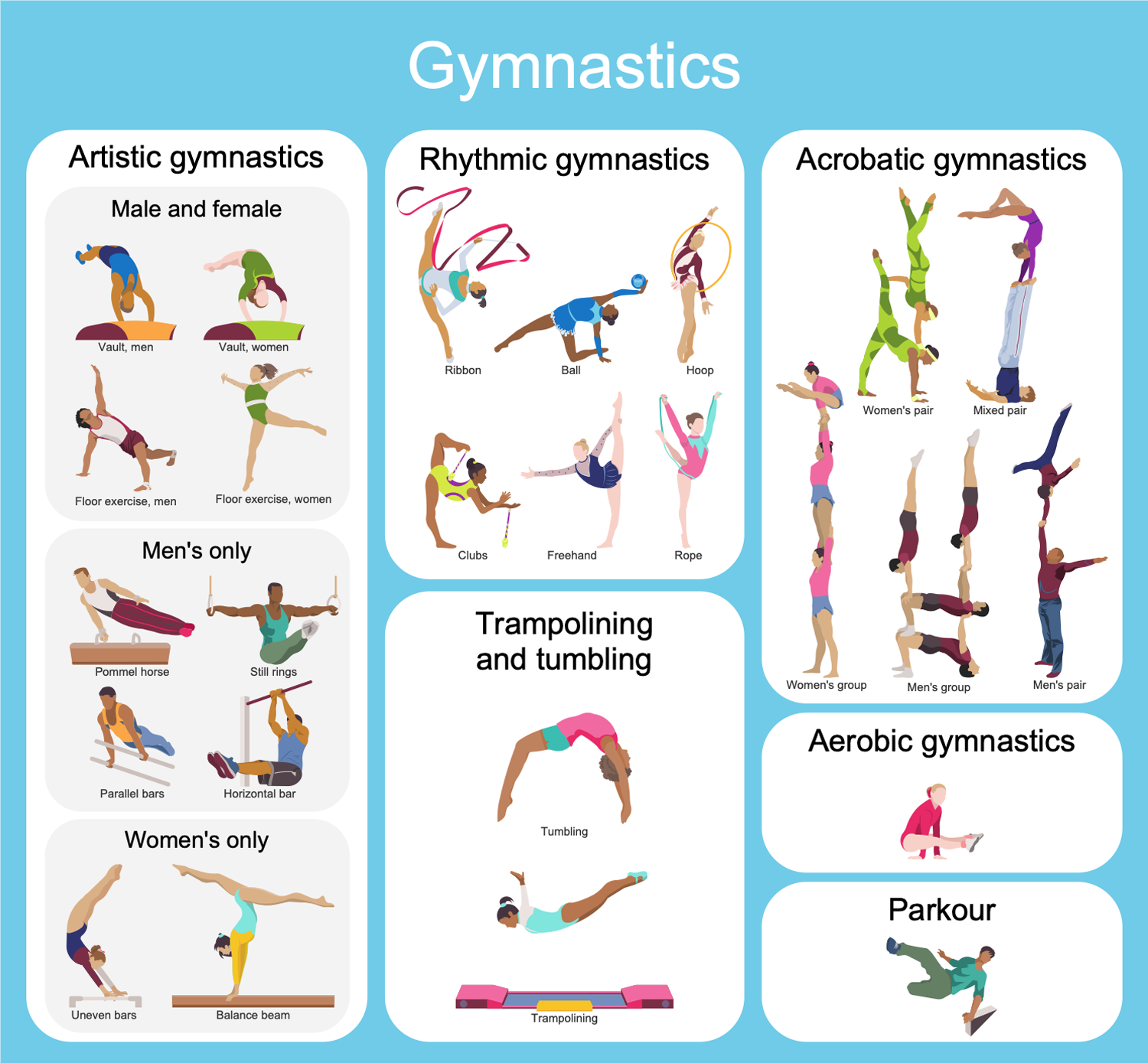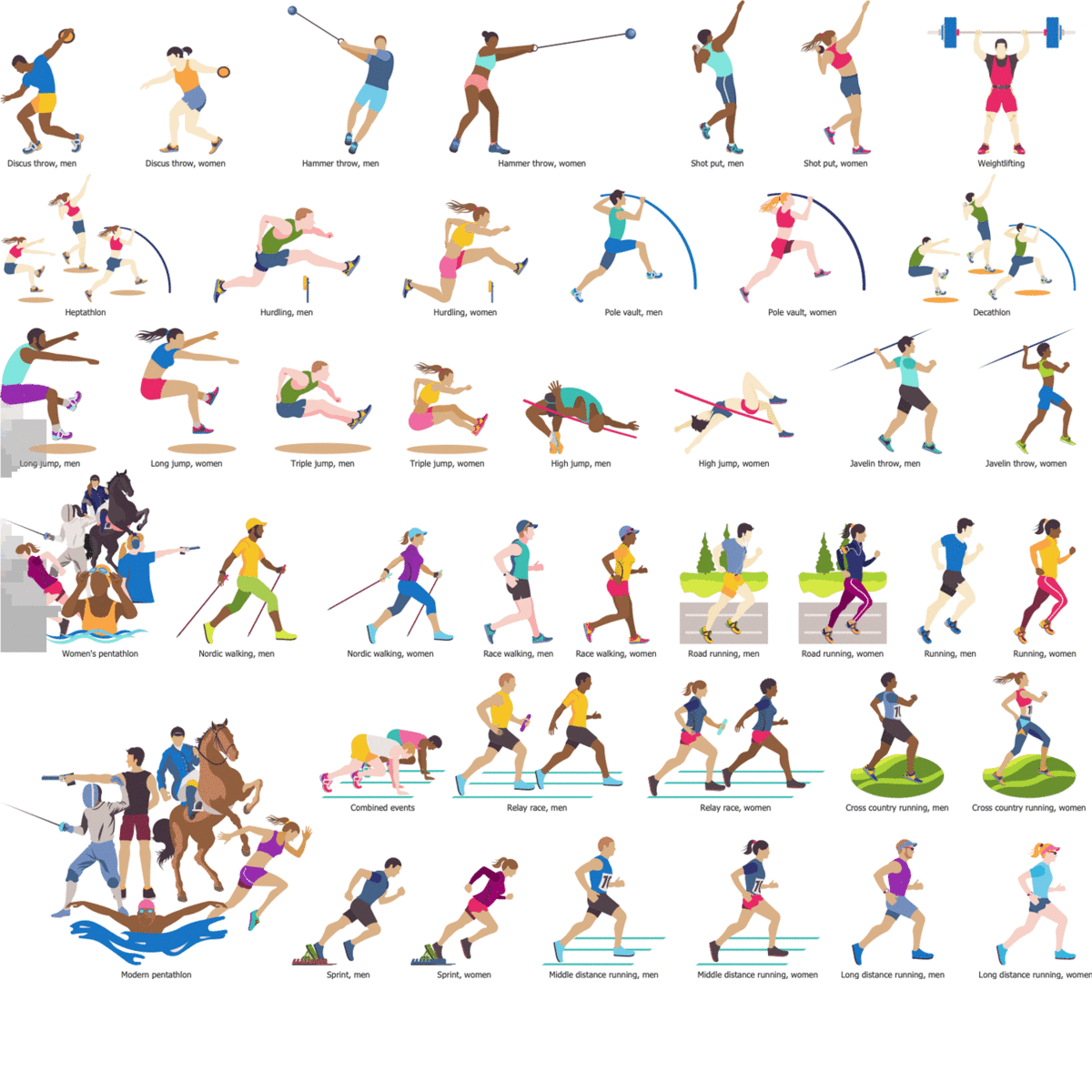Gymnastics Vector
Gymnastics is a kind of sport having a rich history and originated from ancient Greece — Sparta and Athens. The term 'gymnastics' derives from the Greek verb γυμνάζω (gymnazo) meaning to 'train naked' because athletes in ancient Greece really exercised without clothing. Physical training was a highly valued attribute in ancient Greece and both men and women participated in gymnastics training. At that time gymnastics was focused on discipline, strength, strictness, and achieving great records. Later gymnastics was applied to train men for war. The physical training of the body was combined with education of the mind and allowed to introduce more aesthetic and individual approach. Of the modern events currently considered as gymnastics, only tumbling and primitive forms of vaulting were known in the ancient world.
Gymnastics is a system of physical exercises aimed at general comprehensive physical development and improvement. This sport supposes systematic physical activities and exercises for all body muscle groups — legs, arms, shoulders, back, chest, abdomen. It is directed at the development of the body's strength, flexibility, coordination, balance, endurance, agility. Often gymnastics involves the use of rings, bars, and other apparatus — either as a competitive sport or to improve the main sport skills and physical conditioning.
Don Francisco Amorós y Ondeano and Friedrich Ludwig Jahn were the first people who introduced educative gymnastics in France and Germany in the 18th century. At that time the parallel bars, rings, and high bar were invented. Since the foundation of the Federation of International Gymnastics (FIG) in Liege in 1881 to the present moment, it governs the international gymnastics competitions. In 1896 men's gymnastics competitions were included in the first modern Olympic Games. The synchronized team floor calisthenics, running, rope climbing, high jumping, and horizontal ladder were included as gymnastics group to the competitions. The women's Olympic competition was first held in 1928.

Example 1. Gymnastics Vector Illustrations Design
Today 6 types of gymnastics are officially recognized and included in Olympic Games:
- Artistic gymnastics (men’s and women’s) is the most common form of competitive gymnastics for women and men of different ages including children. It includes 4 events for women and 6 for men. Women compete in floor exercises, uneven bars, vault, and balance beam. The events for men include floor exercises, vault, still rings, pommel horse, parallel bars, and horizontal bar. Competitions include team and individual events.
- Rhythmic gymnastics is a gymnastics kind only for women with a greater emphasis on aesthetics and less on acrobatics. The jumps, leaps, tosses, and other moves are performed and 5 different apparatuses like hoop, ribbon, rope, ball, and clubs are used. Rhythmic gymnastics was first introduced in Olympics in 1984. The rhythmic gymnasts compete in individual events, individual all-around, and group competitions.
- Trampoline gymnastics became a part of the Olympics only in 2000. It includes high-flying jumps, flips, and twists. In Olympics are included the individual events for both women and men.
- Power tumbling is performed on a spring runaway or a tumbling track and includes complicated flips and twists in an explosive series. Initially, the event was introduced in Men’s Artistic Gymnastics in 1932, now it is conducted for both men and women.
- Acrobatic Gymnastics is a competitive gymnastic discipline, both men and women gymnasts work in groups of two, three, or four. They perform acrobatic moves, dance, and tumbling with the music. It is not an Olympics event, but it is a part of the U.S. Junior Olympics program and is competed internationally. There are 5 competitive event categories: women’s pairs, women’s groups of 3, men’s pairs, men’s groups of 4, and mixed pairs.
- Aerobic gymnastics originated from traditional aerobics. It emphasizes strength, flexibility, and aerobic fitness. The complex and high-intensity elements are performed to music. Aerobic gymnastics involves performances by individual men and women, mixed pairs, trios, and groups of 5 people. It is not also held at the Olympics.
Example 2. Gymnastics Vector Design Elements
The use of illustrations, diagrams and infographics is the most effective way of visual presenting information about all kinds of sports — winter, summer and all-season. ConceptDraw DIAGRAM diagramming and vector drawing software offers the Summer Sports solution from the Sport area of ConceptDraw Solution Park. It includes an enormous number of vector design objects and clipart gathered to solution libraries and collection of pre-made samples and templates for quick and simple designing sport illustrations and gymnastics vector infographics.
Example 3. Summer Sports Libraries Design Elements
The infographics you see on this page were created in ConceptDraw DIAGRAM software using the Summer Sports Solution and included pre-made pictograms and clipart. They successfully demonstrate the solution's capabilities and professional results you can achieve. An experienced user spent 10-15 minutes creating each of these samples.
Use the powerful tools of the Summer Sports Solution for ConceptDraw DIAGRAM software to create your own infographics and diagrams of any complexity fast and easy, and then successfully use them in your work and personal activity.
All source documents are vector graphic documents. They are available for reviewing, modifying, or converting to a variety of formats (PDF file, MS PowerPoint, MS Visio, and many more graphic formats) from the ConceptDraw STORE. The Summer Sports Solution is available for all ConceptDraw DIAGRAM users.

